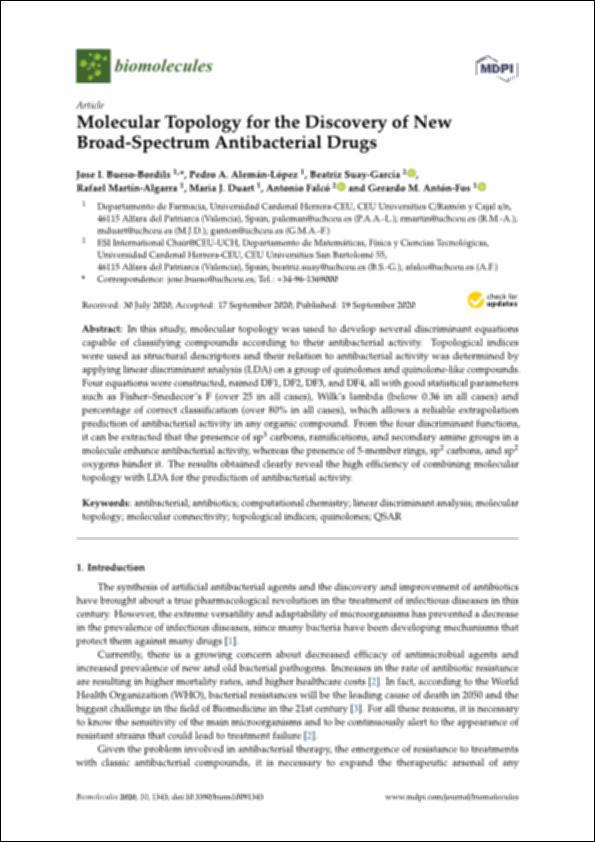Por favor, use este identificador para citar o enlazar este ítem:
http://hdl.handle.net/10637/12572Molecular topology for the discovery of new broad-spectrum antibacterial drugs
| Título : | Molecular topology for the discovery of new broad-spectrum antibacterial drugs |
| Autor : | Bueso Bordils, José Ignacio Alemán López, Pedro Suay García, Beatriz Martín Algarra, Rafael Vicente Duart Duart, María José Falcó Montesinos, Antonio Antón Fos, Gerardo Manuel |
| Materias: | Pharmaceutical microbiology - Mathematical models.; Topología - Aplicaciones en bioquímica.; Biología molecular - Modelos matemáticos.; Molecular biology - Mathematical models.; Topology in biochemistry.; Antibióticos - Modelos matemáticos.; Molecular pharmacology - Mathematical models.; Quinolone antibacterial agents - Mathematical models.; Microbiología farmacéutica - Modelos matemáticos.; Datos masivos.; Big data.; Quinolonas - Modelos matemáticos.; Farmacología molecular - Modelos matemáticos.; Antibiotics - Mathematical models. |
| Editorial : | MDPI |
| Citación : | Bueso-Bordils, J.I., Alemán-López, P.A., Suay-García, B., Martín-Algarra, R., Duart, M.J., Falcó, A. et al. (2020). Molecular topology for the discovery of new broad-spectrum antibacterial drugs. Biomolecules, vol. 10, i. 9 (19 sep.), art. 1343. DOI: https://doi.org/10.3390/biom10091343 |
| Resumen : | In this study, molecular topology was used to develop several discriminant equations capable of classifying compounds according to their antibacterial activity. Topological indices were used as structural descriptors and their relation to antibacterial activity was determined by applying linear discriminant analysis (LDA) on a group of quinolones and quinolone-like compounds. Four equations were constructed, named DF1, DF2, DF3, and DF4, all with good statistical parameters such as Fisher–Snedecor’s F (over 25 in all cases), Wilk’s lambda (below 0.36 in all cases) and percentage of correct classification (over 80% in all cases), which allows a reliable extrapolation prediction of antibacterial activity in any organic compound. From the four discriminant functions, it can be extracted that the presence of sp3 carbons, ramifications, and secondary amine groups in a molecule enhance antibacterial activity, whereas the presence of 5-member rings, sp2 carbons, and sp2 oxygens hinder it. The results obtained clearly reveal the high e ciency of combining molecular topology with LDA for the prediction of antibacterial activity. |
| Descripción : | Este artículo se encuentra disponible en la siguiente URL: https://www.mdpi.com/2218-273X/10/9/1343 Este artículo pertenece al número especial "Big Data analysis in biomolecular research, bioinformatics, and systems biology with complex networks and multi-label machine learning models". |
| URI : | http://hdl.handle.net/10637/12572 |
| Derechos: | http://creativecommons.org/licenses/by/4.0/deed.es |
| ISSN : | 2218-273X (Electrónico). |
| Fecha de publicación : | 19-sep-2020 |
| Centro : | Universidad Cardenal Herrera-CEU |
| Aparece en las colecciones: | Dpto. Farmacia |
Los ítems de DSpace están protegidos por copyright, con todos los derechos reservados, a menos que se indique lo contrario.


